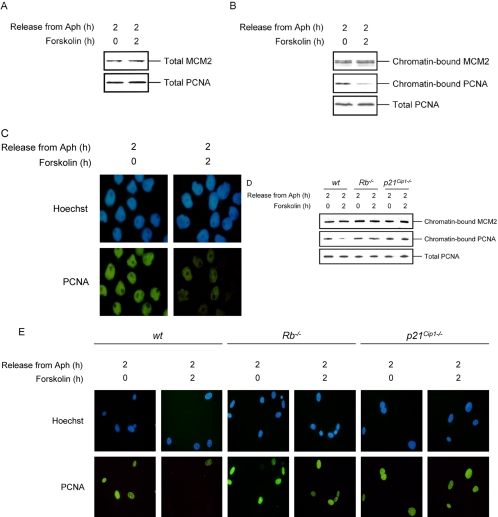Figure 5.
cAMP-mediated inhibition of DNA synthesis correlates with the disruption of PCNA tethering to DNA. (A) S phase–synchronized Reh cells were treated with vehicle or forskolin for 2 h. Cells were harvested, and lysates were prepared, resolved by SDS-PAGE, and detected by immunoblotting with PCNA and MCM2 antibodies. (B) Nuclei isolated from S phase–synchronized Reh cells that were exposed to vehicle or 100 μM forskolin for 2 h were treated with Triton X-100 to separate soluble proteins from the chromatin-bound pellet fraction (Materials and Methods). The extracted nuclei were further treated with MNase to solubilize the chromatin. The MNase-solubilized fraction was resolved on SDS-PAGE and immunoblotted with PCNA and MCM2 antibodies. (C) S phase–synchronized Reh cells were treated with vehicle or 100 μM forskolin and harvested after 2 h. Cells were cytospun onto coverslips, extracted, and then fixed in paraformaldehyde before staining with PCNA antibodies. (D) Wt, Rb-/-, and p21Cip1-/- 3T3 cells were synchronized in S phase with Aph and then treated with vehicle or forskolin for 2 h. Nuclei were then isolated and processed as in B for detection of chromatin-bound PCNA by immunoblotting with anti-PCNA antibodies. (E) Wt, Rb-/-, and p21Cip1-/- 3T3 cells were seeded on coverslips, synchronized in S phase with Aph, and then treated with vehicle or forskolin for 2 h. Coverslips were then processed as in C for immunofluorescence staining with PCNA antibodies.

